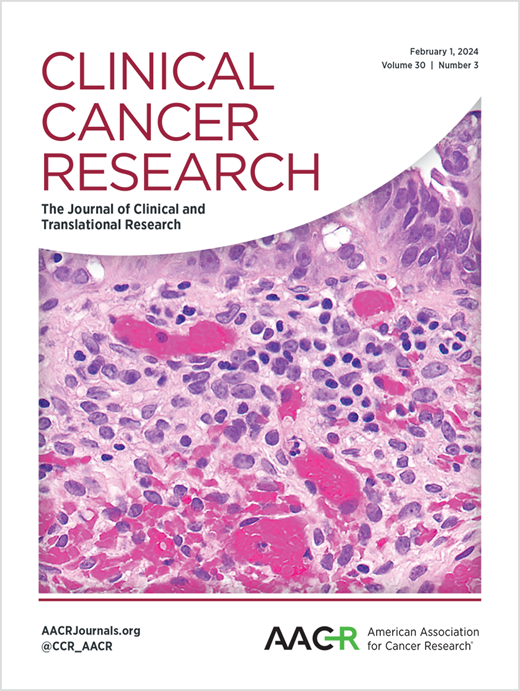Checkpoint Blockade Combinations in High Tumor Mutational Burden/Load Tumors: Insights from the Atezolizumab + Bevacizumab and Nivolumab + Ipilimumab Cohorts in DRUP.
IF 10.2
1区 医学
Q1 ONCOLOGY
引用次数: 0
Abstract
PURPOSE To evaluate the efficacy of atezolizumab plus bevacizumab (atezo+beva) in tumors with high tumor mutational burden (TMB; number of mutations per megabase), and nivolumab plus ipilimumab (nivo+ipi) in tumors with high TMB or tumor mutational load (TML; total number of non-synonymous mutations across the genome). PATIENTS AND METHODS Patients with treatment-refractory, solid tumors were treated in the Drug Rediscovery Protocol (2023-509152-33-00). Patients with microsatellite stable tumors harboring a TML of 200-1000, or TMB of 11-24 (Oncomine) or 15-39 (TSO500) were eligible for nivo+ipi. Similar patients with a panel-independent TMB ≥16 received atezo+beva. Clinical benefit (CB; confirmed objective response or stable disease ≥16 weeks) was the primary endpoint. Whole-genome and RNA-sequencing were performed on pre-treatment tumor biopsies. RESULTS Among 25 evaluable patients with 14 different tumor types treated with atezo+beva, the CB-rate (CBR) was 60% (95% confidence interval [CI], 39-79), with an objective response rate (ORR) of 24% (95% CI, 9-45) and median duration of response (mDoR) of 25.0 months (95% CI, 13.8-NA). In the nivo+ipi cohort the CBR was 50% (95% CI, 29-71) and ORR 37.5% (95% CI, 19-59) among 24 evaluable patients with 13 distinct tumor types. The mDoR was not reached after a median follow-up of 36 months. In both cohorts, responses were only observed in patients with TMB >20, and TMB and (clonal) TML were significantly correlated with response. Various markers of adaptive immune infiltration were associated with longer progression-free survival. CONCLUSIONS Atezo+beva and nivo+ipi showed durable responses in patients with TMB >20, underscoring their tumor-agnostic efficacy in this patient population.高肿瘤突变负担/负荷肿瘤的检查点阻断联合:来自DRUP中Atezolizumab +贝伐单抗和Nivolumab + Ipilimumab队列的见解
目的评估atezolizumab联合贝伐单抗(atezo+beva)在高肿瘤突变负荷(TMB;每兆碱基突变数)的肿瘤中的疗效,以及nivolumab联合ipilimumab (nivo+ipi)在高TMB或肿瘤突变负荷(TML;全基因组非同义突变总数)的肿瘤中的疗效。患者和方法治疗难治性实体肿瘤患者在药物再发现方案(2023-509152-33-00)中进行治疗。TML为200-1000,TMB为11-24 (Oncomine)或15-39 (TSO500)的微卫星稳定肿瘤患者适合nivo+ipi。TMB≥16的类似患者接受atezo+beva治疗。临床获益(CB;证实客观缓解或病情稳定≥16周)是主要终点。治疗前肿瘤活检进行全基因组和rna测序。结果在25例可评估的14种不同肿瘤类型的患者中,atezo+beva治疗的cb率(CBR)为60%(95%可信区间[CI], 39-79),客观缓解率(ORR)为24% (95% CI, 9-45),中位缓解持续时间(mDoR)为25.0个月(95% CI, 13.8-NA)。在nivo+ipi队列中,24例可评估的13种不同肿瘤类型患者的CBR为50% (95% CI, 29-71), ORR为37.5% (95% CI, 19-59)。中位随访36个月后仍未达到mDoR。在这两个队列中,仅在TMB患者中观察到应答,TMB和(克隆)TML与应答显著相关。适应性免疫浸润的各种标志物与更长的无进展生存期相关。结论satezo +beva和nivo+ipi在TMB患者中表现出持久的疗效,表明它们在TMB患者中具有肿瘤不可知的疗效。
本文章由计算机程序翻译,如有差异,请以英文原文为准。
求助全文
约1分钟内获得全文
求助全文
来源期刊

Clinical Cancer Research
医学-肿瘤学
CiteScore
20.10
自引率
1.70%
发文量
1207
审稿时长
2.1 months
期刊介绍:
Clinical Cancer Research is a journal focusing on groundbreaking research in cancer, specifically in the areas where the laboratory and the clinic intersect. Our primary interest lies in clinical trials that investigate novel treatments, accompanied by research on pharmacology, molecular alterations, and biomarkers that can predict response or resistance to these treatments. Furthermore, we prioritize laboratory and animal studies that explore new drugs and targeted agents with the potential to advance to clinical trials. We also encourage research on targetable mechanisms of cancer development, progression, and metastasis.
 求助内容:
求助内容: 应助结果提醒方式:
应助结果提醒方式:


